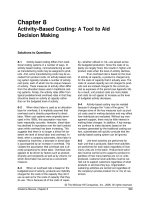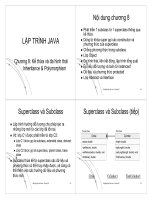Kendall7E ch08
Bạn đang xem bản rút gọn của tài liệu. Xem và tải ngay bản đầy đủ của tài liệu tại đây (2.03 MB, 56 trang )
Analyzing Systems
Using Data
Dictionaries
Systems Analysis and Design,
7e
Kendall & Kendall
© 2008 Pearson Prentice Hall
8
Learning Objectives
• Understand analysts use of data dictionaries
•
•
•
for analyzing data-oriented systems
Create data dictionary entries for data
processes, stores, flows, structures, and logical
and physical elements of the systems being
studied, based on DFDs
Understand the concept of a repository for
analysts’ project information and the role of
CASE tools in creating them
Recognize the functions of data dictionaries in
helping users update and maintain information
systems
Kendall & Kendall
8-2
Cataloging
• Data flow diagrams can be used to
catalog
• Data processes
• Flows
• Stores
• Structures
• Elements
• Cataloging takes place with the data
dictionary
Kendall & Kendall
8-3
Major Topics
• The data dictionary
• The data repository
• Defining data flow
• Defining data structures
• Defining data elements
• Defining data stores
• Using the data dictionary
• XML
Kendall & Kendall
8-4
The Data Dictionary
• A reference work of data about
data (metadata)
• Collects and coordinates data
terms, and confirms what each
term means to different people in
the organization
Kendall & Kendall
8-5
Need for Understanding the
Data Dictionary
• Provide documentation
• Eliminate redundancy
• Validate the data flow diagram
• Provide a starting point for developing
screens and reports
• Determine the contents of data stored in
files
• To develop the logic for DFD processes
• Create XML
Kendall & Kendall
8-6
The Data Repository
• A data repository is a large collection of
project information
• It includes:
• Information about the data maintained by the
system
• Procedural logic and use cases
• Screen and report design
• Data relationships
• Project requirements and final system
deliverables
• Project management information
Kendall & Kendall
8-7
Figure 8.1 How data
dictionaries relate to data
flow diagrams
Kendall & Kendall
8-8
Data Dictionary Categories
• Data flows
• Data structures
• Elements
• Data stores
Kendall & Kendall
8-9
Defining the Data Flow
•
•
•
•
•
•
•
•
•
ID - identification number
Unique descriptive name
A general description of the data flow
The source of the data flow
The destination of the data flow
Type of data flow
The name of the data structure describing the
elements
The volume per unit time
An area for further comments and notations
Kendall & Kendall
8-10
Figure 8.3 An example of a data flow
description from World’s Trend Catalog
Division
Kendall & Kendall
8-11
Describing Data Structures
• Data structures are made up of
smaller structures and elements
• An algebraic notation is used to
describe data structures
Kendall & Kendall
8-12
Algebraic Notation
• Equal sign, meaning “is composed of”
• Plus sign, meaning "and”
• Braces {} meaning repetitive
elements
• Brackets [] for an either/or situation
• Parentheses () for an optional element
Kendall & Kendall
8-13
Figure 8.4 Data structure example for adding a
customer order at World’s Trend Catalog Division
Kendall & Kendall
8-14
Structural Records
• A structure may consist of elements or
structural records
• These are a group of elements, such as:
• Customer Name
• Address
• Telephone
• Each of these must be further defined
until they are broken down into their
component elements
Kendall & Kendall
8-15
Structural Records Used in
Different Systems
• Structural records and elements that
are used within many different systems
are given a non-system-specific name,
such as street, city, and zip
• The names do not reflect a functional
area
• This allows the analyst to define them
once and use in many different
applications
Kendall & Kendall
8-16
Structural Record Example
Kendall & Kendall
8-17
Logical and Physical Data
Structures
• Logical
• Show what data the business needs
for its day-to-day operations
• Physical
• Include additional elements necessary
for implementing the system
Kendall & Kendall
8-18
Physical Data Structures
• Key fields used to locate records
• Codes to identify record status
• Transaction codes to identify
different record types
• Repeating group entries
• Limits on items in a repeating group
• Password
Kendall & Kendall
8-19
Figure 8.6 An element description form
example from World’s Trend Catalog
Division
Kendall & Kendall
8-20









